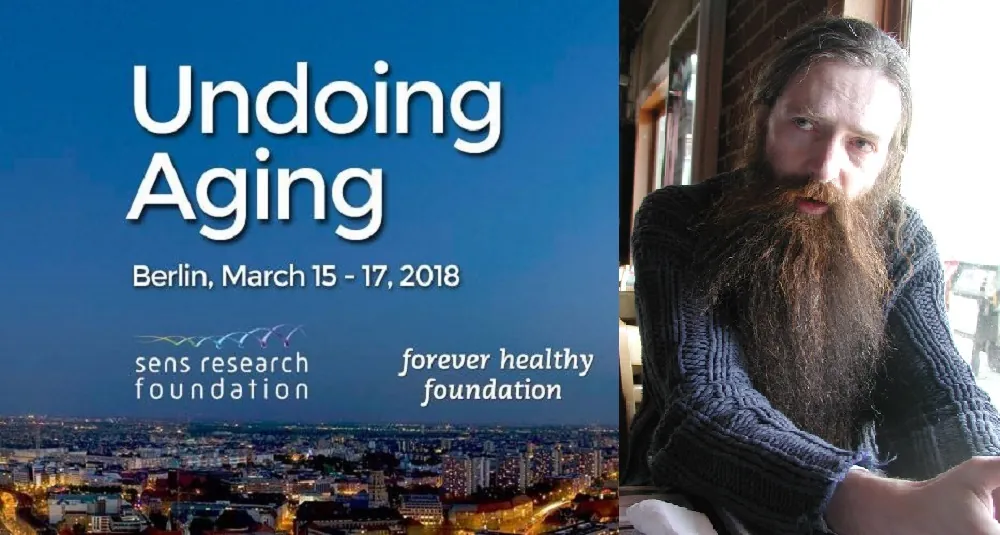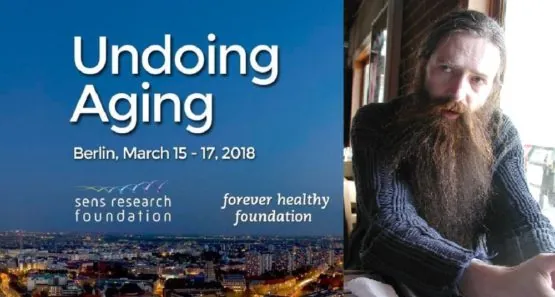As the Undoing Aging 2018 Conference approaches, excitement and interest about the event are growing among both aging scientists and rejuvenation enthusiasts alike. If you’re a regular on our blog, neither Undoing Aging 2018’s main organizer, SENS Research Foundation, nor the main sponsor, Michael Greve’s Forever Healthy Foundation, need much of an introduction, but for the benefit of any newcomers, here’s a brief summary of all you need to know before diving into the questions that we’ve asked the SRF team on behalf of the members of the growing rejuvenation community.
SENS Research Foundation
SENS Research Foundation is a medical research charity based in California and the UK. A spin-off of the Methuselah Foundation, SRF is the engine room of research on biotechnologies against aging. Co-founded by Dr. Aubrey de Grey, the first proponent of the so-called “maintenance approach” to aging, the foundation has, over the years, funded and conducted cutting-edge research on the known root causes of aging, producing solid evidence that rejuvenation biotechnologies that can undo the damage of aging may be achievable within a few decades, given sufficient effort and funding.
Forever Healthy Foundation and the Undoing Aging 2018 Conference
Effort is not a problem; while initially controversial, the maintenance approach is now endorsed and pursued by some of the most eminent names of gerontology, not to mention the start-up companies that have spun off SRF itself or conduct SENS-related research. However, funding is still an issue, and this is where the Forever Healthy Foundation has stepped in.
The Forever Healthy Foundation’s stated goal is to be part of the first generation to cure aging. In order to achieve this ambitious goal, the foundation is actively investing significant sums into research and advocacy. The Undoing Aging 2018 Conference, to be held in Berlin on March 15-17, 2018, is part of the foundation’s outreach efforts. The event, open to everyone, will feature leading scientists from all over the world, and it is meant to offer a first-hand understanding of the current state of research in the emerging field of rejuvenation medicine.
The Undoing Aging 2018 SENS Interview Part One
We have been working with the life extension community on the Lifespan Discord server and collecting the best questions about research progress and developments in the field. Dr. Aubrey de Grey and other SRF team members kindly took the time to answer these questions for us. This is the first of our three-part Undoing Aging 2018 interview, which we will publish over three days in support of the Undoing Aging 2018 conference.
Why did you choose Berlin and not California or elsewhere in the USA for the event?
Aubrey: Basically, because the suggestion came from our main German donor, Michael Greve, who is also the conference’s main sponsor. Hard to argue with that!
Will the Undoing Aging conference 2018 be live-streamed and later have videos uploaded so that people can watch the conference at their convenience?
Aubrey: It won’t be live-streamed, but many of the presentations will be available for viewing on our website afterwards.
Can you explain what the motivation was for this show and, in particular, the change from the invite-only format to being open to the wider community?
Aubrey: It’s not really a change – more of a reversion to past practice. The RB conference last year was relatively small, and we wanted it to be available mostly to investors and opinion-formers, but we have in no way lost sight of the role of educated laypeople.
Is SRF planning to make Undoing Aging into a recurring event, much like the Rejuvenation Biotechnology conferences in America?
Aubrey: We’ll certainly be continuing to do both more science-centred events like Undoing Aging and the SENS Conferences, as well as more rejuvenation biotechnology industry-oriented events like the Rejuvenation Biotechnology series, but we haven’t yet decided on the sequence and orientation of future meetings.
With the Undoing Aging show this year, will there be an RB2018, or is this new show format replacing it?
Aubrey: We are still working on that question. We certainly want to maintain a strong conference presence in California, but it may be best to do that with smaller, more frequent events, such as the one we did with the California Life Sciences Association.
Recently, SRF has received significant donations amounting to over 7 million dollars. What priorities does SRF plan to address with this money?
Aubrey: First and foremost, we will be gearing up our existing programs in mitochondrial gene replacement, scaling up glucosepane research, rejuvenation biotechnology against cytosolic aggregates, and so on. We will also be initiating new ones; those are still being discussed with potential extramural collaborators, but you can expect some announcements later this year.
They will all be within the same seven-strand framework that has defined SENS since the beginning. And after having sometimes in the past allocated nearly all of our available research budget at the beginning of the fiscal year and thereby limiting our ability to take advantage of new opportunities that arose later in the year, we will be maintaining a research reserve fund so that we are always poised to get good work funded year-round.
For anyone reading this who is thinking about doing the same as our recent donors, I will just say that we are a very long way from running out of productive ways to invest more money.
What is the current status of the SENS Project 21?
Aubrey: Project 21 was created in order to give greater focus and exposure to our efforts to attract major donations from high-net-worth individuals. It is necessarily an initiative whose success is hard to measure for a while, since, by definition, such donations are very sporadic. However, with the receipt of so much in cryptocurrency over the past few months, nearly all of it in the form of four 7-digit donations, I think it’s fair to say that Project 21 is flourishing. We certainly hope that such donations will accelerate!
Is SRF trying to reach out to other celebrities than those already involved in the “Reimagine Aging” campaign? Are there any celebrities in particular whose endorsement may significantly help spread more awareness?
Aubrey: The Reimagine Aging celebrity campaign was a few years ago; we have not been focused on recruiting celebrities in recent years. We always welcome new people who can carry our message to a wide audience. As to individual celebrities, each person advocates for rejuvenation research and the vision of a future free of age-related debility and disease in their own way, bringing different personal symbolism or personal stories to their advocacy, and will thereby be compelling to different audiences.
How important do you think the work of organizations such as LEAF/Lifespan.io are in respect to their activities in advocacy and fundraising? Does our presence make your job easier?
Aubrey: Oh, it’s massive. Thank you so much for existing! I have always felt (and said) that the single biggest thing that this mission needs on the outreach side is diversity: that I can do what I can, but ultimately there are large audiences out there who just aren’t receptive to my way of saying things but who may be much more receptive to other voices saying materially the same thing. Also, we mustn’t forget the simple manpower aspect – like anyone else, I have only 24 hours in my day.
During our advocacy, we often find that people use terms like ‘immortality’ and ‘living forever’ to describe the work we are involved in. What influence do you think such words have on the credibility of the field and also on advocacy efforts?
Aubrey: I’ve been on the record for some time as saying that such terminology is not helpful. Most people who support biomedical intervention in aging who speak in such terms are using it in a stipulative sense to mean what they call “biological immortality” — by which they mean no manner of “immortality” at all, but rather a medical solution to end age-related debility and death. If that’s what they mean, they should just say so! To call this “immortality” (including “biological immortality”) simply confuses the discussion and makes people think that you’re saying things that you don’t mean. It reduces your credibility while also raising concerns that don’t apply to eliminating one very widespread and particularly terrible cause of death.
Policymakers are typically conservative towards disruptive biotechnologies, such as genetic engineering. How do you expect they will react once the first rejuvenation treatments are proven to work? Do you expect a lot of obstructionism, heavy regulations, and perhaps even attempts to ban these treatments, or do you think that politicians will understand the importance of rejuvenation without much need for lobbying from advocates?
Aubrey: Actually, I don’t expect significant amounts of either reaction. We’ve clearly seen already that the vast majority of people (whether bioethicists, or policymakers, or the person on the street) who express reservations about hypothetical therapies that would greatly extend life expectancy will nonetheless still express their support for therapies that would prevent or reverse individual, specific diseases of aging. But remember, rejuvenation biotechnology will not come in the form of a single, permanent ‘cure’ for aging like we have for many infectious diseases. Instead, there will be multiple rejuvenation biotechnologies, each targeting a different kind of cellular or molecular aging damage.
Because various specific diseases of aging are driven primarily by small subsets of such damage, individual rejuvenation biotechnologies will therefore initially appear as treatment and prophylaxis against those specific diseases, with relatively minor effects on life expectancy when considered in isolation. I am supremely confident that the support for each such therapy will be very strong and the opposition confined to a very small number of ever-more isolated ideological holdouts.
Additionally, remember that truly dramatic effects on life expectancy will — of mathematical necessity — not begin to manifest for decades after an entire panel of such therapies is widely available and in use as a comprehensive regimen. It is implausible that any strong constituency will arise in the intervening decades to insist that individual patients be denied any one of these therapies — let alone all of them — because of feared consequences for life expectancy and related social consequences decades into the future.
That concludes part one of our Undoing Aging 2018 interview; check out parts two and three, which we will publish here on our blog over the next two days.


